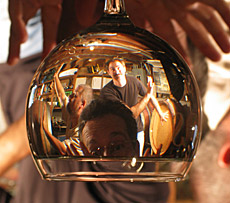Let’s do the numbers
 Got the numbers back from ETS, and as we guessed from the taste of the grapes, the Merlot should have been picked earlier. The upshot is that we’ll need to strap the Merlot to the treadmill and tone it up a bit, adding some acid to drop its pH into healthier territory and sharpen its fruit, and perhaps add some water to pull the potential alcohol down into balance.
Got the numbers back from ETS, and as we guessed from the taste of the grapes, the Merlot should have been picked earlier. The upshot is that we’ll need to strap the Merlot to the treadmill and tone it up a bit, adding some acid to drop its pH into healthier territory and sharpen its fruit, and perhaps add some water to pull the potential alcohol down into balance.
The Franc looks a lot better, but like the Merlot, will need to be monitored through the ferment because of their low yeast assimilable nitrogen content (or more colorfully, YANC). That potentially soporific term essentially characterizes how much nitrogen the yeast have to feed on to keep themselves fit and healthy through the ferment. From a paper by the Food Science and Technology department at OSU:
If the levels of fermentable nitrogen are too low, the total cell biomass produced will be low, the yeast fermentation may be slow, and the fermentation may stop or `stick’ before all the fermentable sugar is utilized. Yeast under nutritional stress due to nitrogen deficiency may also produce hydrogen sulfide (rotten egg) and other sulfur compounds with offodors
So we’ll definitely be adding some yeast nutrient and tasty-sounding di-ammonium phosphate (DAP) to both of these ferments to keep the yeasts happy and healthy.
The complete numbers and some more comments after the jump…
First, let me stress that I’m not a professional winemaker, so my read on what these numbers mean is definitely not authoritative. What little knowledge I have is based on repeated and annoying questions to friends who are real winemakers (most of them pinot noir producers), patient ETS staff, and trial and error (mostly the latter) over 13 years. So take what I say below with a grain of metabisulfite, and feel free to correct me or add your own interpretations in the comments.
Here are the Merlot numbers:
brix 24.6 degrees glucose + fructose 25.5 g/100mL potential ethanol (OIV) 15.2 % vol pH 3.71 titratable acidity 0.37 g/100mL tartaric acid 3.71 g/L L-malic acid 1.56 g/L potassium 1720 mg/L alpha-amino compounds 46 mg/L ammonia 40 mg/L yeast assimilable nitrogen 79 mg/L (as N)
For me, the key numbers are the sugar (or brix), the resulting potential alcohol, the pH, the titratable acidity (or TA), and the summation of alpha-amino compounds and ammonia that make up YANC. I know the potassium in Eastern Washington soils is particularly high, but that pretty much exhausts my knowledge of potassium (except that bananas are also high in potassium: so are E. Washington soils therefore composed of bananas? Hmmm).
Unless you’re going for a high-powered, critic-pleasing wine (versus one you can actually enjoy with a meal), I think alcohol levels below 14% are the way to go. Of course, it’s ultimately a question of balance: I’ve had quite a few muscular wines that worked beautifully because the high alcohol was balanced by a lot of fruit, acid and tannin. But in general, those are what I think are appropriately called cocktail wines – wines you drink by themselves, for the pleasure of them but also because they’ll flatten anything you eat with them outside of a hunk of seared meat.
Here at Les Garagistes, we’re too hungry to put up with them for long, so we shoot for less alcoholic wines. So I’m thinking we’ll probably add a little water to the must to pull the alcohol down somewhere in the low 14s. (I heard one critic memorably categorize this practice as adding “Jesus units” – turning water into wine.) And as with all additions, the earlier the better.
That pH is also scary, since it indicates not only a low acidity (to which pH is loosely tied), but less protection for the must from disease, since acidity works as a preservative in wine. I’d like to see the pH closer to 3.5 or so, so we’ll probably be adding 2g/liter tartaric acid to tart things up a bit and ensure a healthy, non-flabby wine.
Finally, we’ll be adding a dusty cocktail of SuperFood (yeast nutrient) and DAP at key stages through the ferment to bolster the yeasts in their quest for total satiation. This is probably even more critical since we’re trying wild yeast fermentations this year.
And here are the Cabernet Franc numbers:
Brix 22.8 degrees glucose + fructose 23.7 g/100mL potential ethanol (OIV) 14.1 % vol pH 3.72 titratable acidity 0.4 g/100mL tartaric acid 3.86 g/L L-malic acid 1.65 g/L potassium 1570 mg/L alpha-amino compounds 123 mg/L ammonia 78 mg/L yeast assimilable nitrogen 187 mg/L (as N) Merlot
These look a lot better to me. I’d have loved a spoonful more sugar, but you can see that the pH is already pretty high (as is the TA), so this is probably a good compromise. Certainly the must tastes great.
I’d advocate for an acid addition here, but probably be a little more conservative than with the Merlot since there isn’t as much fruit to balance it out. Perhaps start with 1g/liter and see how it tastes and how far it nudges the pH.
You can also see that the YAN number is much more healthy here. We’ll still add some nutrient, but it’s not nearly the risk the Merlot is.
Any other comments on these numbers?
No commentsNo comments yet. Be the first.
Leave a reply
